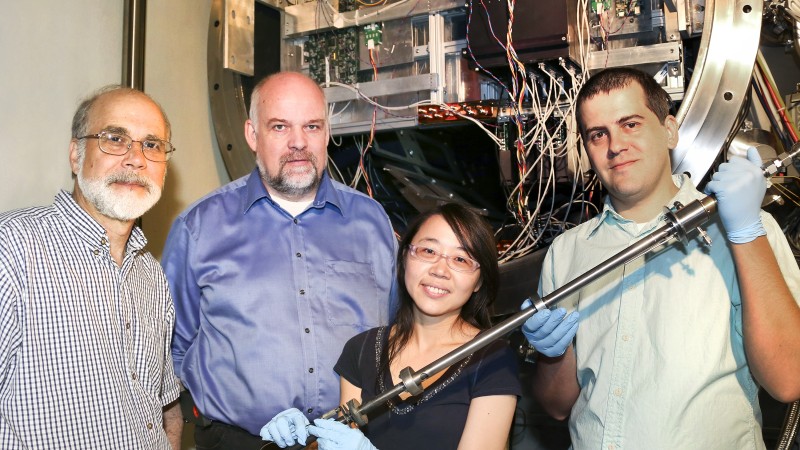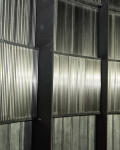Scientists at the US Department of Energy’s Oak Ridge National Laboratory are learning how the properties of water molecules on the surface of metal oxides can be used to better control these minerals and use them to make products such as more efficient semiconductors for organic light emitting diodes and solar cells, safer vehicle glass in fog and frost, and more environmentally friendly chemical sensors for industrial applications.
The behavior of water at the surface of a mineral is determined largely by the ordered array of atoms in that area, called the interfacial region. However, when the particles of the mineral or of any crystalline solid are nanometer-sized, interfacial water can alter the crystalline structure of the particles, control interactions between particles that cause them to aggregate, or strongly encapsulate the particles, which allows them to persist for long periods in the environment. As water is an abundant component of our atmosphere, it is usually present on nanoparticle surfaces exposed to air.
A great scientific challenge is to develop ways to look closely at the interfacial region and understand how it determines the properties of nanoparticles. The ORNL researchers are taking advantage of two of the lab’s signature strengths—neutron and computational sciences—to reveal the influence of just a few monolayers of water on the behavior of materials.
In a set of papers published in the Journal of the American Chemical Society and the Journal of Physical Chemistry C, the team of researchers studied cassiterite (SnO2, a tin oxide), representative of a large class of isostructural oxides, including rutile (TiO2). These minerals are common in nature, and water wets their surfaces. The behavior of water confined on the surface of metal oxides readily relates to applications in such diverse areas as heterogeneous catalysis, protein folding, environmental remediation, mineral growth and dissolution, and light-energy conversion in solar cells, to name just a few.
When metal oxide nanoparticles are produced, they spontaneously adsorb water from the atmosphere, bonding it to their surface, explained Hsiu-Wen Wang, a research scientist currently at the ORNL–University of Tennessee Joint Institute for Neutron Sciences who performed this research while conducting a postdoctoral fellowship in the Chemical Sciences Division (CSD) at ORNL. This water can interfere with the function of SnO2-containing products in surprising ways that are hard to predict. Wang’s team used neutron scattering at ORNL’s Spallation Neutron Source (SNS) to help understand the role that bound water plays in the stability of SnO2 nanoparticles and to learn more about the bound water’s structure and dynamics. Wang said neutrons are perfect for studying light elements such as the hydrogen and oxygen that make up water, and molecular dynamics simulations are an ideal tool to reinforce the observations. In fact, hydrogen is essentially invisible to X-ray and electron beams but scatters neutrons strongly, making neutron diffraction and inelastic scattering the ideal tools for probing the properties of water and other hydrogen-bearing species.
"When we drive all the water off the surface of the nanoparticles, this destabilizes the structure of the nanoparticles, and they grow larger," said David J. Wesolowski, a co-author and Wang’s supervisor when she worked in CSD.
"The lifetime of engineered nanoparticles in the environment is an important environmental safety and health issue," Wesolowski said. "We show that water sorbed on the nanoparticles, which naturally happens when they are exposed to normal humid air, prolongs their lifetimes as nanomaterials, thus prolonging their potential environmental impacts. In addition, the high surface area of nanoparticles is desirable. If the particles grow, which happens as they are heated and dehumidified, their surface area drops rapidly."
To remove sorbed water, the nanoparticles are heated under vacuum. Water dissipation begins at around 250°C (nearly 500°F, or about as hot as you can set your kitchen’s oven). Much energy is required to drive off the water completely from the nanoparticles, which stay stable to these relatively high temperatures precisely because of the presence of the bound water. Once the water begins to dissipate, destabilization begins. Before completing this study, researchers did not know to what degree the removal of water would cause destabilization.
"It may be that the surfaces without water have different and useful chemical properties, but because water is everywhere in the environment, it is very important to know that the surfaces of oxide nanoparticles are likely to be already covered with a few molecular layers of water," Wesolowski said.
Researchers used SNS’s Nanoscale-Ordered Materials Diffractometer (NOMAD) instrument to determine the structure of water on cassiterite nanoparticle surfaces, as well as the structure of the particles themselves. NOMAD is dedicated to local structure studies of various materials from liquids to nanoparticles, using the neutron scattering pattern produced during experiments, said Mikhail Feygenson, NOMAD instrument scientist.
"The combination of the high neutron flux of SNS and the wide detector coverage of NOMAD enables rapid data collection on very small samples, like our nanoparticles,” Feygenson said. “NOMAD is much faster than similar instruments around the world. In fact, the measurements of our samples that took about 24 hours of NOMAD time could have required as much as a full week on a similar instrument at another lab."
The second step of the study took place at SNS on the Fine-Resolution Fermi Chopper Spectrometer (SEQUOIA), which allows for forefront research on dynamical processes in materials. “This part of the study focuses on the role of surface hydrogen bonds and the surface water vibrational properties,” said Alexander Kolesnikov, SEQUOIA instrument scientist.
The NOMAD and SEQUOIA studies enabled the research team to validate computational models they created to fully capture the structural ordering of the surface-bound water on the SnO2 nanocrystals. Integrating neutron scattering experiments with classical and first principles molecular dynamics simulations provided evidence that strong hydrogen bonds—as strong as in water under ultrahigh pressure of >500,000 atm—drive water molecules to dissociate at the interfaces and result in a weak interaction of the hydrated SnO2 surface with additional water layers.
"The results are significant in demonstrating many new features of surface-confined water that can provide general guidance into tuning of surface hydrophilic interactions at the molecular level," said Jorge Sofo, professor of physics at Pennsylvania State University.
This research was supported by the US Department of Energy’s Office of Science. The research team for this project also included Rick Paul of the National Institute of Standards and Technology; Mark J. DelloStritto, Nitin Kumar, and James D. Kubicki of Pennsylvania State University; and Thomas Proffen, Paul R.C. Kent, Lukas Vlcek, Wei Wang, Lawrence Allard, Alexander Kolesnikov, and Lawrence Anovitz from ORNL. The Spallation Neutron Source is a DOE Office of Science User Facility.
—Wendy Hames and Katie Bethea
Published Work:
H.-W. Wang, M. DelloStritto, N. Kumar, A. I. Kolesnikov, P. R. C. Kent, J. D. Kubicki, D. J. Wesolowski, and J. O. Sofo, "Vibrational density of states of strongly H-bonded interfacial water: Insights from inelastic neutron scattering and theory." The Journal of Physical Chemistry C, 118, 10805–1083 (2014); DOI: 10.1021/jp500954v.
H.-W. Wang, D. J. Wesolowski, T. E. Proffen, L. Vlcek, W. Wang, L. F. Allard, A. I. Kolesnikov, M. Feygenson, L. M. Anovitz, and R. L. Paul, "Structure and stability of SnO2 nanocrystals and surface-bound water species," Journal of the American Chemical Society, 135, 6885–6895 (2013); DOI: 10.1021/ja312030e.









